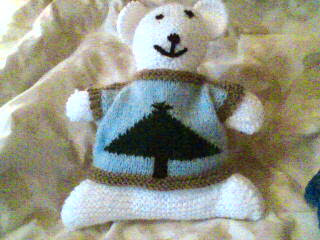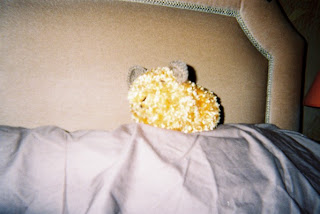This design is from an old Stitchcraft magazine (from the 1940s).
Here is a close-up of the stitch pattern:
Knitting, tatting, embroidery, crochet...
Please click on any image to see a larger version.
Tuesday, 31 August 2010
Monday, 30 August 2010
Lacy knitted top
This sleeveless top is knitted in a mohair yarn.
Here is the stitch in detail:
The lacy effect is achieved by winding the yarn around the needle several times, dropping the extra loops and knitting them together in groups, and then increasing into the group to return to the original number of stitches.
Here is the stitch in detail:
The lacy effect is achieved by winding the yarn around the needle several times, dropping the extra loops and knitting them together in groups, and then increasing into the group to return to the original number of stitches.
Sunday, 29 August 2010
Crochet fish
The fish has a drawstring mouth because he holds a bar of soap!
I cheated with the tail, which is knitted rather than crocheted, but the dorsal fin is crocheted. The eye is embroidered...does he look a little dozy, perhaps?
I cheated with the tail, which is knitted rather than crocheted, but the dorsal fin is crocheted. The eye is embroidered...does he look a little dozy, perhaps?
Saturday, 28 August 2010
Friday, 27 August 2010
Thursday, 26 August 2010
Sunflower design in Hardanger embroidery
Here is a design that I created and worked some years ago. It is a sunflower in Hardanger.
What makes this unusual is that Hardanger is usually worked in white thread on white fabric, giving a lacy effect when the threads in the fabric are cut and withdrawn. The fabric is stabilised by areas of satin stitch known as Kloster blocks; these prevent fraying and unravelling. The bars of thread remaining (some only vertical, others only horizontal) are woven with a finer embroidery thread in the same colour as the satin stitch. The embroidery is worked in coton perle (pearl cotton), which has a lustre. Here I have used a range of different colours to create the sunflower and the leaves. It is pictured against a terracotta background to highlight the areas of withdrawn threads.
What makes this unusual is that Hardanger is usually worked in white thread on white fabric, giving a lacy effect when the threads in the fabric are cut and withdrawn. The fabric is stabilised by areas of satin stitch known as Kloster blocks; these prevent fraying and unravelling. The bars of thread remaining (some only vertical, others only horizontal) are woven with a finer embroidery thread in the same colour as the satin stitch. The embroidery is worked in coton perle (pearl cotton), which has a lustre. Here I have used a range of different colours to create the sunflower and the leaves. It is pictured against a terracotta background to highlight the areas of withdrawn threads.
Tuesday, 24 August 2010
Knitted guinea pig
Adapted a knitting pattern for a mouse to make a guinea pig as a present for my vet's young son. I used an "eyelash" yarn, knitted the ears in double knitting and embroidered the features.
A close-up of ginger piggy:
The finished toy is life size.
A close-up of ginger piggy:
The finished toy is life size.
Toy piggies don't eat hay or grass, so this little chap is nestling in some green ribbon.
Looks like he made short work of that!
Subscribe to:
Posts (Atom)











